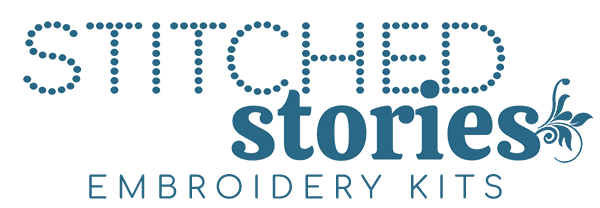Master 12 classic embroidery stitches and you are on your way to hours of getting creative with thread and needle. Below are embroidery stitch how-tos with illustrations and examples.
If you’d like a printable guide to the stitches described below, click here to request the booklet printable: Hand Embroidery Stitching Guide.

Straight Stitch.
Bring needle and thread up through fabric at 1. Insert the needle back in at 2, and make a straight line.


Satin Stitch
Bring needle and thread up at edge of shape you’re filling (1). Insert at the other side of shape (2). Come back up a little below 1 (3).


Outline Stitch
Bring needle and thread up through fabric at 1. Insert needle back into fabric a stitch-width to the right (2) and then come back up just before the previous stitch (3). The result is overlapping stitches. (NOTE: you’ll start at the LEFT end of line to be stitched.)


Back Stitch
Bring needle and thread up through fabric at 1. Insert needle back into fabric a stitch-width to the right (2) and then come back up a stitch-width to the left (3) of the thread. (NOTE: You’ll start at the RIGHT end of line to be stitched.)


Whipped Back Stitch
Stitch the design completely with Back Stitch. Then pass needle under 1st stitch (1). Come back over that stitch (2), and then go under the next stitch (3). Do this again and again so that all of stitches are wrapped.


Split Stitch
Do this like the Back Stitch EXCEPT, enter right through the middle of the previous stitch rather than to the left of it. This is great for tight detailed curvy lines.


Lazy Daisy
Bring needle and thread up at 1. Insert back at same spot and up at 2. As you do this, loop working thread under needle at 2. Pull the thread all the way through and create a snug loop under the working thread. Insert needle back down very near 2 to secure. Loops can be combined to created a full flower.


Chain Stitch
Bring needle and thread up at 1. Insert at the same spot and up at 2. As you do this, loop working thread under the needle at 2. Pull thread all the way through to create a snug loop under the thread. Repeat by inserting needle at 2 and coming up a stitch ahead–again with the working thread looping under the needle.


French Knot
Bring needle and thread up through fabric at 1. Wrap thread twice around needle (front to back). Hold thread taut and insert needle back very very close to 1. Continue keeping thread taut. Slide wrapped thread down to fabric and pull needle all the way through to the back–which creates the French Knot on top of the fabric.


Fly Stitch
Fly Stitch. Bring needle and thread up at 1. Insert to the side at 2 and back up at 3. As you do this, loop working thread under needle at 3. Pull the thread all the way through and pull snugly to create a “V”. Insert needle back down very close to 3 to secure. Taut, deep stitches will look like a “V” and looser, shorter stitches like scallops.


Leaf Stitch
Leaf Stitch. Bring thread up at top center of leaf (1) and insert about halfway down the leaf (2). Come up a bit to the left of top center (3) and insert below bottom of last stitch (4). Come up a bit to the right of top center (5) and insert again at 4. Continue working side to side along top and filling to bottom of leaf.


Wagon Wheel Stitch (aka Rosette Stitch)
Wagon Wheel. Add 5 straight stitches that go from outer edge of circle into center. Come up next to center. Weave needle and thread over and under the “spokes” of wheel, going around until wheel is full. At end insert needle at wheel edge, hidden just under the last round. Don’t pull too tightly as you weave. Let the thread layer up to create a rosette.


Embroidery that celebrates homey comforts...
Morning coffee, kind words, or slow napping afternoons, take your pick. These best-selling favorites are perfect for a kitchen nook, a thoughtful gift, and cozy handmade touches.



